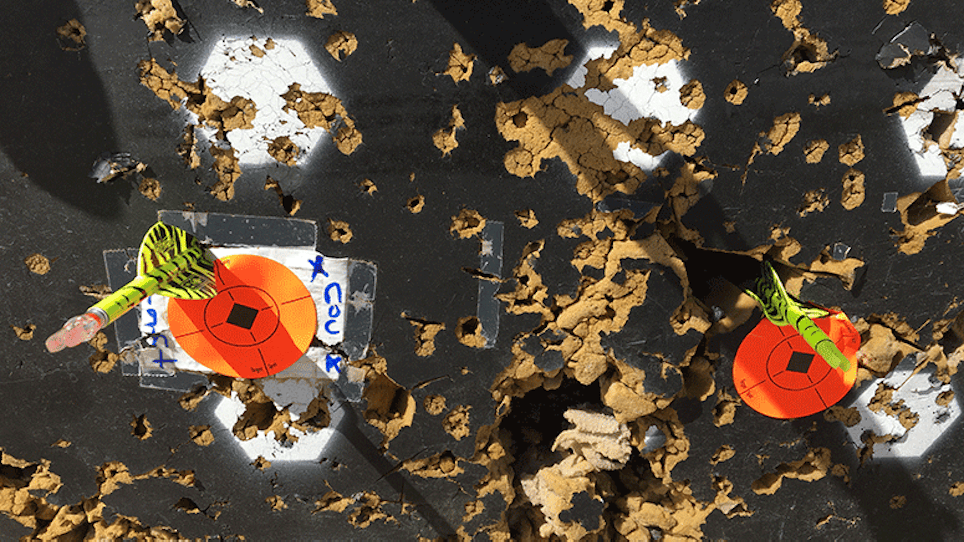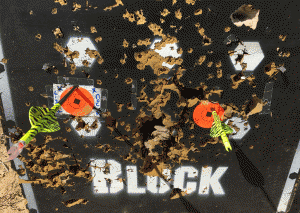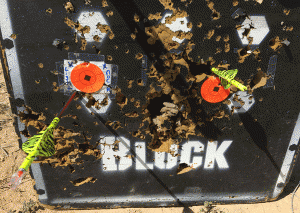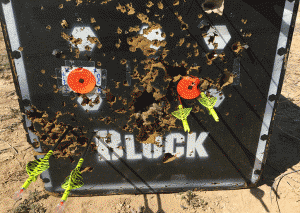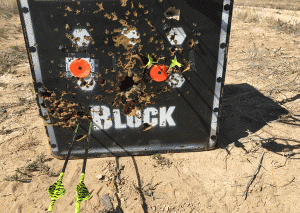A lifelong resident of the state of Colorado, I still find lighted nocks to be somewhat of a mystery. Sure, I could use them when I crossed state lines, but I’m not a big fan of changing my setup from week to week. In 2015, the Centennial State finally passed a law allowing the use of these “know right where I hit my animal” beauties, and it didn’t take long for me to jump on the glowing arrow bandwagon.
Last year was a busy “deer year” for me, but all of my hunts were for whitetails, which meant 20-, 30- and 40-yard shots. I noticed very little difference between my standard nock arrow impact and lighted nock arrow (which was 20 grains heavier) impact. I did some testing before simply making the switch and discovered there was zero arrow impact difference at 20 and 30 yards, and at 40 yards the arrow with the lighted nock impacted the target about 1.5 inches lower than the standard nock arrow. Because I hold for dead-center lungs, I didn’t even tweak my 40-yard pin.
Late in the 2015 season I received a call from a good buddy – a resident of Maine – who had gone West on a mule deer hunt. He prepared well for the hunt, shooting regularly out to 80 yards. When he arrived at camp, he noticed many of the other hunters were shooting lighted nocks. They convinced him to do the same. He inserted one into his practice arrow, slung the arrow at a 40-yard Block and was satisfied with the impact. The following afternoon he shot under a world-class buck at 56 yards. He was sick. Why did he miss? I think you know the answer. Yep, after returning to camp he discovered he was almost 7 inches low at 56 yards shooting a lighted nock. Ouch!
I once again have a heavy deer year – six states over the next four months – but this time I have a pair of mule deer tags in my pocket. I figured this would be a good time to conduct a standard nock vs. lighted nock field test, and for the last two days I’ve been tinkering on the southeastern plains. Here are the no-frill, no-nonsense results.
- Bow: Hoyt Defiant Turbo set at 29-inch draw and 65-pound draw weight.
- Arrow: Victory VAP TKO Gamer V3 in a 350 spine.
- Nock: Standard Bohning G Nock (6.6 grains) and Nockturnal Red G Nock (19.6 grains).
Field Points: The average weight of six tested field points was 99.5 grains.
*Total average arrow weight with standard G nock was 410.9 grains.
*Total average arrow weight with lighted G nock was 423.9.
Note: All shooting tests were performed without the use of a Hooter Shooter or other mechanical shooting devices. Every arrow fired was triggered by the author in wind speeds ranging between 2 and 6 mph.
- Distance: 20 Yards – No discernable difference was noticed at a distance of 20 yards.
- Distance: 30 Yards – No discernable difference was noted at a distance of 30 yards.
- Distance: 40 Yards – The Nockturnal G nock was on average 2.6 inches low at 40 yards.
- Distance: 50 Yards – The Nockturnal G nock was on average 5.8 inches low at 50 yards.
- Distance: 60 Yards – The Nockturnal G nock was on average 8.1 inches low at 60 yards.
Are you planning to shoot lighted nocks this year? I highly recommend it! If so, I would also suggest doing some serious testing with your bow setup before simply swapping out your standard nocks for those that glow.
